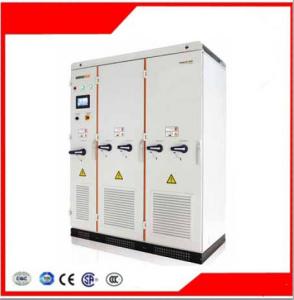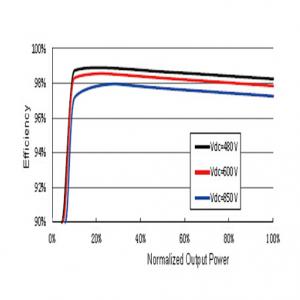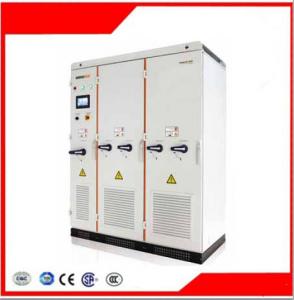Photovoltaic Grid-Connected Inverter SG500MX-M
- Loading Port:
- China Main Port
- Payment Terms:
- TT or LC
- Min Order Qty:
- 50 unit
- Supply Capability:
- 1000 unit/month
OKorder Service Pledge
OKorder Financial Service
You Might Also Like
1. Structure of Photovoltaic Grid-Connected Inverter SG500MX-M Description
A solar inverter, or PV inverter, or Solar converter, converts the variable direct current (DC) output of a photovoltaic (PV) solar panel into
autility frequency alternating current (AC) that can be fed into a commercial electrical grid or used by a local, off-grid electrical network.
It is acritical BOS–component in a photovoltaic system, allowing the use of ordinary AC-powered equipment. Solar inverters have
special functions adapted for use with photovoltaic arrays, including maximum power point tracking and anti-islanding protection.
Suitable for 50Hz/60Hz grid, could be used in Asia, North America and Europe.
2. Main Features of the Photovoltaic Grid-Connected Inverter SG500MX-M
• Advanced three-level circuit structure improves product's performance
• 4-MPPT, wide MPP voltage range
• Modular design, long operation time
• Film bus capacitors with long lifespan
• Rotating the modules in use extends the inverter's lifespan
• Inverter sleeping at night doubles the PCB lifespan
• Elevated cooling performance and protection level ensures reliable operation
• Less THD, more grid-friendly
• Less common-mode interference, more environment-friendly
• Compatible with two-winding transformer
• Flexible setting of 1 to 4 MPPT
• Reactive compensation on asymmetric power grid
• Direct parallel connection at low voltage side, easy to expand the capacity
• Comprehensive modular design
• All components front-maintenance
• Draw-type modules, service friendly design
• Less THD, more grid-friendly
• Less common-mode interference, more environment-friendly
• Compatible with two-winding transformer
• Flexible setting of 1 to 4 MPPT
• Reactive compensation on asymmetric power grid
• TÜV, CE, CGC certification, compliance with BDEW
3. Photovoltaic Grid-Connected Inverter SG500MX-M Images
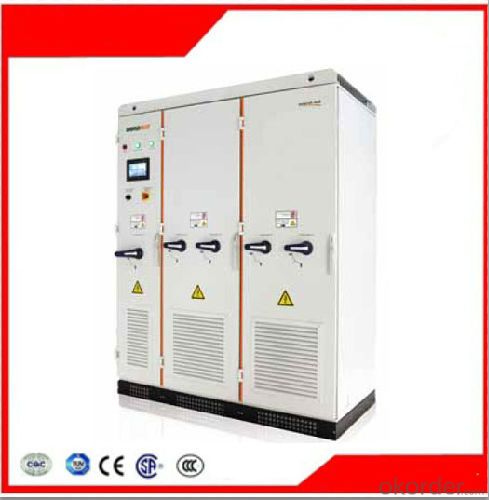
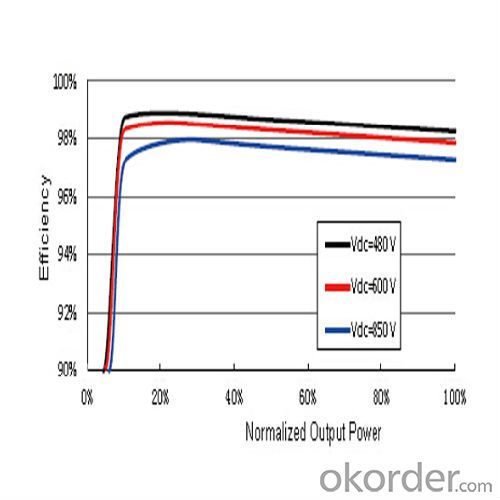
4. Photovoltaic Grid-Connected Inverter SG500MX-M Specification
Input Side Data |
|
Max. PV input power | 560kW |
Max. PV input voltage | 1000V |
Start voltage | 520V |
Min. operation voltage | 480V |
Max. PV input current | 1064A |
MPP voltage range | 480~850V |
No. of MPPTs | 1, 2, 3, 4 |
No. of DC inputs | 2 x 4 |
Output Side Data |
|
Nominal AC output power | 500kW |
Max. AC output apparent power | 550kVA |
Max. AC output current | 1018A |
THD | <3%(Nominal power) |
Nominal AC voltage | 315V |
AC voltage range | 252~362V |
Nominal grid frequency | 50/60Hz |
Grid frequency range | 47~52 / 57~62Hz |
Power factor | >0.99@default value at nominal power, adj. 0.9 overexcited~0.9 underexcited |
Isolated transformer | No |
DC current injection | <0.5 % In |
Efficiency |
|
Max. efficiency | 98.80% |
European efficiency | 98.60% |
Protection |
|
Input side disconnection device | DC load switch |
Output side disconnection device | AC load switch |
DC overvoltage protection | Yes |
AC overvoltage protection | Yes |
Grid monitoring | Yes |
Ground fault monitoring | Yes |
Overheat protection | Yes |
Insulation monitoring | Yes |
General Data |
|
Dimensions(W×H×D) | 1606×2034×860mm |
Weight | 1400kg |
Operating ambient temperature range | -30~+55℃ |
Night power consumption | <100W |
External auxiliary supply voltage | 220V, 8A |
Cooling method | Temperature controlled aircooling |
Ingress protection rating | IP21 |
Allowable relative humidity range | 0~95% no condensing |
Max. operating altitude | 6000m(>3000m derating) |
Fresh air consumption | 5575 m³/h |
Display | Touch screen LCD |
Communication | RS485/Modbus, Ethernet |
5. FAQ of Photovoltaic Grid-Connected Inverter SG500MX-M
Q1. What is the difference between inverter and solar inverter?
A1. Inverter only has AC inpput, but solar inverter both connect to AC input and solar panel, it saves more power.
Q2. What is the difference between MPPT&PWM?
A2. MPPT has higher efficiency, it can track the max power point and won't waste energy.
- Q:How does a solar inverter handle voltage transients?
- A solar inverter handles voltage transients by employing various protective mechanisms such as surge protection devices and voltage regulation techniques. These mechanisms help to stabilize and control the voltage level, ensuring that the inverter is not affected by sudden spikes or drops in voltage. Additionally, the inverter may include features like overvoltage and undervoltage protection, which help to prevent damage to the system during voltage transients.
- Q:How does a solar inverter affect the overall system reliability?
- A solar inverter plays a crucial role in enhancing the overall system reliability of a solar power system. It converts the direct current (DC) generated by solar panels into alternating current (AC) that can be used to power household appliances and feed excess energy into the grid. By efficiently managing and controlling the flow of electricity, a reliable solar inverter ensures smooth operation of the entire system, preventing power fluctuations, voltage surges, and other electrical issues. Additionally, advanced features like anti-islanding protection and monitoring capabilities enable early detection and prevention of potential faults, further enhancing the system's reliability and performance.
- Q:Can a solar inverter be used with a solar-powered water desalination system?
- Yes, a solar inverter can be used with a solar-powered water desalination system. A solar inverter is responsible for converting the direct current (DC) power generated by solar panels into alternating current (AC) power, which is required to operate most electrical appliances and systems. In the case of a solar-powered water desalination system, the solar inverter can be used to convert the DC power generated by solar panels into AC power to run the various components of the desalination system, such as pumps, motors, and control systems.
- Q:How does a solar inverter handle power factor optimization?
- A solar inverter handles power factor optimization by using advanced control algorithms to adjust the phase relationship between the voltage and current supplied by the inverter. This allows the inverter to operate at a power factor close to unity, which maximizes the efficiency and performance of the solar power system.
- Q:What is the purpose of a solar inverter in a solar power system?
- The purpose of a solar inverter in a solar power system is to convert the direct current (DC) electricity produced by solar panels into alternating current (AC) electricity, which is the type of electricity used in most household appliances and the power grid.
- Q:Can a solar inverter be repaired or replaced if it malfunctions?
- Yes, a solar inverter can be repaired or replaced if it malfunctions. In many cases, minor issues can be resolved through repairs, such as replacing faulty components or fixing wiring problems. However, if the malfunction is severe or the inverter is beyond repair, it may need to be replaced with a new one.
- Q:How do you maintain a solar inverter?
- To maintain a solar inverter, regular inspections and cleaning are essential. It is crucial to check for any signs of damage or loose connections, and make sure the inverter is properly ventilated to prevent overheating. Additionally, keeping the surrounding area clean and free from any debris or obstructions can help optimize its performance. It is recommended to follow the manufacturer's guidelines and consult with a professional for any specific maintenance requirements.
- Q:How does a solar inverter handle grid voltage variations?
- A solar inverter is equipped with a voltage regulation mechanism that allows it to handle grid voltage variations. It continuously monitors the grid voltage and adjusts the output voltage of the inverter accordingly to ensure a stable and consistent supply of electricity. This regulation mechanism helps to protect the inverter and the connected solar panels from any potential damage that may occur due to fluctuations in the grid voltage.
- Q:Can a solar inverter be used in a stand-alone solar system?
- Yes, a solar inverter can be used in a stand-alone solar system. In fact, it is an essential component as it converts the direct current (DC) generated by the solar panels into alternating current (AC) that can be used to power electrical devices in a standalone system.
- Q:Can a solar inverter be used with a solar-powered cooling system?
- Yes, a solar inverter can be used with a solar-powered cooling system. A solar inverter is responsible for converting the direct current (DC) electricity generated by solar panels into alternating current (AC) electricity that can be used to power various appliances, including cooling systems. By integrating a solar inverter into a solar-powered cooling system, the system can effectively harness solar energy to operate and provide cooling without relying on external power sources.
1. Manufacturer Overview |
|
|---|---|
| Location | |
| Year Established | |
| Annual Output Value | |
| Main Markets | |
| Company Certifications | |
2. Manufacturer Certificates |
|
|---|---|
| a) Certification Name | |
| Range | |
| Reference | |
| Validity Period | |
3. Manufacturer Capability |
|
|---|---|
| a)Trade Capacity | |
| Nearest Port | |
| Export Percentage | |
| No.of Employees in Trade Department | |
| Language Spoken: | |
| b)Factory Information | |
| Factory Size: | |
| No. of Production Lines | |
| Contract Manufacturing | |
| Product Price Range | |
Send your message to us
Photovoltaic Grid-Connected Inverter SG500MX-M
- Loading Port:
- China Main Port
- Payment Terms:
- TT or LC
- Min Order Qty:
- 50 unit
- Supply Capability:
- 1000 unit/month
OKorder Service Pledge
OKorder Financial Service
Similar products
New products
Hot products
Hot Searches
Related keywords
